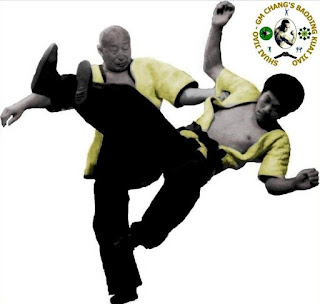By Phillip Starr
I have to agree with them on that point; in my opinion, a given martial discipline must necessarily include both percussive and grappling techniques in order for it to be effective on the street. The renowned judo master, Gunji Koizumi (“Father of British Judo”, who also established the Budokwai) said, “Any martial artist who relies strictly on percussive techniques is doomed to failure.” He was right. The opposite is equally true; any grappling art that fails to teach effective striking techniques (known as “atemi waza” in jujutsu and aikido) is likewise incomplete.
Why did Master Koizumi make such a statement? Aren't percussive techniques more likely to take the fight out of an opponent than a grappling technique? Well, it depends... on many things. Anyone who's ever been in a couple of good barroom scraps will tell you that regardless of how much training you have in punching and kicking, you'd better be able to handle yourself at extremely close quarters – under conditions that are considerably less than optimal for striking and kicking. There's a technical martial arts terms for people who are unable to do this. It is DOGMEAT.
Now, I'm not saying that karate or taekwondo enthusiasts should train assiduously in some of the better-known judo/jujutsu throws such as the shoulder throw, spring hip throw, and the like. But they DO need to learn some simple but effective throws/takedowns to complement their percussive skills. I should mention, by the way, that such grappling techniques have always been part and parcel of the karate repertoire and are to be found in certain katas. The older, original form of taekwondo also included a number of grappling maneuvers which, sadly, seem to have been erased from their modern, sport-oriented curricula. On the other hand, martial arts such as Shorinji Kempo are about half percussive and half grappling.
Although many throws are intended to damage or even kill one's foe, most of them are intended to place the hapless receiver in an untenable position (that's an indefensible position for you rednecks out there). The aggressor is thrown and then struck instantly. To do this quickly - especially in combat - requires great skill, which is not something that can be acquired quickly. Moreover, grappling also necessarily includes a number of joint-twisting techniques. Many throws utilize such techniques as entries to the throw; resisting the throw will result in a broken bone... but going along with it may not allow the receiver to fare any better.
In China, the arts of grappling are referred to as “shuai-jiao” (which is tricky for me because “shuei-jiao” means “go to bed/sleep” and my wife was often perplexed when I got the two mixed up...). Training is extremely rigorous but it produces high-spirited, rugged fighters. Qin-na is the art of joint-twisting, seizing, and choking. It is said that if you are to effectively apply such a technique, your skill must be at least three times greater than that of your enemy. Nonetheless, there's a time and a place for everything and my students train with them very thoroughly. The odds of effective application are greatly increased when preceded by a sharp blow that produces sharp pain...
So, the idea of “mixed martial arts” is nothing new. All traditional martial disciplines were and are, mixed. If they weren't, they wouldn't have survived to the present day.






















No comments:
Post a Comment